![]()
![]()
![]()
Use LEFT and RIGHT arrow keys to navigate between flashcards;
Use UP and DOWN arrow keys to flip the card;
H to show hint;
A reads text to speech;
44 Cards in this Set
- Front
- Back
- 3rd side (hint)
|
Six monitoring points of an ASP? |
Primary Influent, Primary Effluent, Aeration Tank, Secondary Clarifier, Plant Recycles, Plant Effluent |
PI, PC, AT, SC, PR, PE |
|
|
Typically the F/M ratio is adjusted by changing the: |
Sludge Wasting Rate |
|
|
|
What indicates better sludge settleability? |
Lower SVI's |
|
|
|
What should you increase to increase the F/M ratio? increase: |
Sludge Wasting |
|
|
|
Name the four typical microorganisms found in the ASP: |
Bacteria, Protozoa, Rotifiers, Worms |
|
|
|
In an aeration tank, what D.O. range Is favorable for denitrification in mg/l? |
0.2-0.5 mg/l |
|
|
|
The Conventional Activated Sludge Process uses a _____and____ reactor. |
Plug, Flow |
|
|
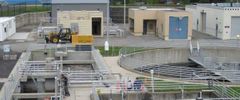
Facts: BOD is absorbed and later metabolized, the max organic loading is no more than 60 lbs/1000Ft3/day, Short Detention Times, unsuitable for nitrification, good for high flows, 2 aeration tanks................................. What process am I? |
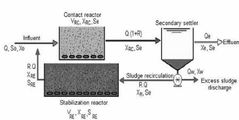
Contact Stabilization |
|
|

Facts: Provides a more uniform distribution of oxygen in the tank, good with shock loads, partial nitrification due to low Detention Times. Primary effluent enters the aeration tank at several points along the length of the tank, rather than at the beginning or head of the tank and flowing through the entire tank in a plug flow mode....................... ...What Process Am I? |

Step Feed |
|
|
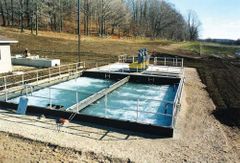
What processes have the longest Aeration time? |
Extender Aeration, (Oxidation Ditch) |
|
|
|
What process has a continuous flow around the ring? |
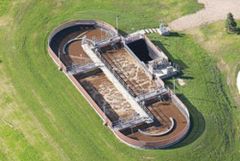
Oxidation Ditch |
|
|
|
Facts: Greater hydraulic loading, more stable microbial population, more efficient aeration, a tolerance for shock loads, used for nitrification, sensitive to Ph drops........... ......What process am I? |
Complete Mix |
|
|
|
Facts: Reduced sludge age, will perform the best in nitrification, long aeration, long MCRT, low rate loading, high hydraulic retention time (about 24 hours), small to medium communities............................................What process am I? |
Extended Aeration/Oxidation Ditch (a type of extended aeration) |
|
|
|
Facts: Nitrogen deficient, high in carbohydrates, poor settling.........................................What process am I? |
Kraus Process |
|
|
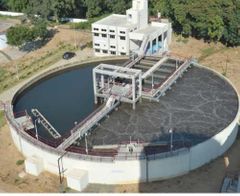
Facts: Deep depths to help with the fill and draw operation, depths of 12-20 Ft, mechanical mixers, can mix with no aeration for nutrient removal and are Single tank. Modified systems are ICEA's that have 2 tanks for continuous flows, This process has periodic inflow and outflow (2 to 6 times a day).What process am I? |
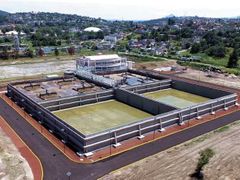
SBR (Sequencing Batch Reactor) |
|
|
|
What does PLC stand for? |
Programmable Logic Controller (used in an SBR) |
|
|
|
What are the 5 stages of an SBR? |
Fill, React, Settle, Decant, Idle |
F, R, S, D, I |
|
|
Key Words: Aerobic, Autotrophic (CO2 as carbon- oxidize inorganic to live), Nitrosomonas, Nitrobacter, No low Alk, Consumes Alk, Needs D.O., High retention time, Low BOD, ammonia to ammonium, Blue Bay Syndrome, Oxygen added mechanically, Autotrophic bacteria, Lowers Ph, Warm water, MCRT 8 to 20 days, |
Nitrification |
|
|
|
Key Words: Anoxic (D.O. <0.3), No D.O., methanol as carbon source, Pseudomonas, Achromobacter, Heterotrophic bacteria (organic carbon to live), acetic acid, facultative bacteria (aerobic or anoxic) |
Denitrification |
|
|
|
The same in nature is: |
Homogenous |
|
|
|
What word means it can be solid, liquid or gas? |
Heterogeneous |
|
|
|
Facts: Air supply is parallel with oxygen demand, Oxygen demand is high at entrance and is low at tail end, Diffused air or surface aerators, Reduces power costs...What am I? |
Tapered Aeration ASP's |
|
|
|
Facts: Combo ASP and membrane filtration, no secondary clarifier, Better Effluent quality, a high MLSS can be maintained, expensive, foul odors...What am I? |
Membrane Bio Reactors (MBR) |
|
|
|
Facts: Small to medium communities, low O/M cost, modular-compact design, no primary clarifier or anaerobic digester, uses extended aeration, Large A.T.'s, long MCRT's (more than 30 days) What am I? |
Package Plants |
|
|
|
_______diffusers are more prone to fouling and require more maintenance. |
Porous |
|
|
|
_________ diffusers need less maintenance and can be cleared by bumping the air. |
Non Porous |
|
|
|
Fine bubble diffusers usually get porous surface clogging due to ____ and ____. |
dirt, biological growth |
|
|
|
Coarse diffusers clog due to ________, or they ______. |
bio growth, break |
|
|
|
Some sludge is being removed continuously to be used as _______ sludge in the aeration tanks. The excess sludge must be removed before it loses its activity because of the death of the aerobic organisms resulting from lack of ______ at the bottom of the tank. |
returned, oxygen |
|
|
|
___________ is also commonly termed as the solids retention time (SRT) or mean cell residence time (MCRT). Historically, sludge age has been calculated as a "ratio" of the total solids in aeration to the "weight" of total solids in the aeration tank influent. |
Sludge Age |
|
|
|
Having a ____ F:M ratio, means you have too many bacteria in your wastewater system relative to the incoming Biochemical Oxygen Demand (BOD). This causes starvation of healthy floc forming bacteria, and issues such as bulking, or high effluent Total Suspended Solids (TSS). |
Low |
|
|
|
A ______ F:M ratio means there is a greater quantity of food (measured as BOD, COD, or TOC) relative to the quantity of microorganisms available to consume that food. When the F:M ratio is high, the bacteria are active and multiply rapidly but they are also more dispersed in suspended growth bioreactors. |
high |
|
|
|
_________ removes solids buildup in the activated-sludge system, formed when solids amounts in the aeration-tank influent are greater than the solids amounts in the secondary-clarifier effluent. If sludge is not wasted, the secondary clarifier eventually fills up with solids. |
Wasting |
|
|
|
What do thick billows of white sudsy foam in your aeration tank indicate? READ THIS |
High F/M Ratio: Thick billows of white sudsy foam in the aeration tank is often encountered during the start-up of a treatment plant. In this stage, there aren’t many microorganisms in the aeration tank, but there’s plenty of food (BOD) coming in. When you calculate the F/M ratio, you’ll get a larger number because the “F” or food is a big number, while the “M” or microorganism population is fairly small. |
|
|
|
When _________ is added to wastewater, it decreases the pH because it forms acids when it is mixed with wastewater. Whenever acids are formed in liquid, they will lower the pH, since acids have low pH. |
Chlorine Gas |
|
|
|
Another characteristic that’s associated with thick billows of white sudsy foam in the aeration tank is ________, which is a group of microorganisms that hasn’t spent a lot of time in the aeration tank. |
Young Sludge |
|
|
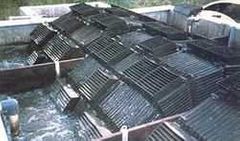
________are a conventional aerobic biological wastewater treatment unit. Conventional biological treatment means activated sludge systems and fixed film systems such as trickling filters. It is a biological fixed-film treatment process used in the secondary treatment of wastewater following primary treatment. The primary treatment process involves removal of grit, sand and coarse suspended material through a screening process, followed by settling of suspended solids. |
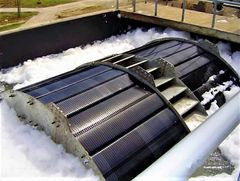
Rotating Biological Contactor (RBC) |
|
|
|
Facts: Air supply is parallel with oxygen, oxygen is highest at entrance, oxygen is lowest at the tail end, reduces power costs, is sometimes used to avoid nitrification |
Tapered Aeration |
|
|
|
Facts on RAS: |
The purpose of Return Activated Sludge (RAS) is to prevent loss of microorganisms from the aeration tank and maintain an adequate population for treatment of the wastewater. As microbes metabolize their substrate, they grow and multiply in number. Suspended Solids Insoluble solids that either float on the surface of or are in suspension in wastewater or other liquids. Return Activated Sludge (RAS) Sludge that is recycled between secondary clarifiers and aeration tanks to maintain an active biomass for secondary treatment. |
|
|
|
Facts on WAS: |
Some sludge is being removed continuously to be used as returned sludge in the aeration tanks. The excess sludge must be removed before it loses its activity because of the death of the aerobic organisms resulting from lack of oxygen at the bottom of the tank. Wasting removes solids buildup in the activated-sludge system, formed when solids amounts in the aeration-tank influent are greater than the solids amounts in the secondary-clarifier effluent. If sludge is not wasted, the secondary clarifier eventually fills up with solids. |
|
|
|
_________ - A pure chemical substance that is used in chemical tests to measure, detect, or examine other substances. |
Reagent |
|
|
|
________ - A dissolved phase of an element or compound. |
Soluble |
|
|
|
________- The dissolved component of a solution. |
Solute |
|
|
|
___________ Solution - A solution in which the exact concentration of a chemical or compound is known. |
Standard |
|

